Popular categories
Looking for a yarn?

75% Wool, 25% Polyamide
from 2.30 £ /50g
Order DROPS Fabel from Wool Warehouse Direct Ltd

|
DROPS Fabel uni colour 75% Wool, 25% Polyamide |
2.30 £ /50g |
Order |

|
DROPS Fabel 75% Wool, 25% Polyamide |
2.40 £ /50g |
Order |

|
DROPS Fabel long print 75% Wool, 25% Polyamide |
2.60 £ /50g |
Order |
Clicking the ORDER button will redirect you to Wool Warehouse Direct Ltd website
Order DROPS Brushed Alpaca Silk from Wool Warehouse Direct Ltd

|
DROPS Brushed Alpaca Silk uni colour 77% Alpaca, 23% Silk |
2.90 £ /25g |
Order |
Clicking the ORDER button will redirect you to Wool Warehouse Direct Ltd website
Order DROPS Needles & Hooks
Clicking the ORDER button will redirect you to Wool Warehouse Direct Ltd website
The yarn cost is calculated from the pattern’s smallest size and the yarn’s cheapest product type. Looking for an even better price? You might find it on the DROPS Deals!
Stormy Evening Sweater
Knitted jumper in DROPS Fabel and DROPS Brushed Alpaca Silk. The piece is worked top down in stocking stitch with European/diagonal shoulders and double neck. Sizes S - XXXL.
DROPS Design: Pattern fa-536
Yarn group C + A or D
-------------------------------------------------------
SIZES:
S - M - L - XL - XXL - XXXL
YARN:
DROPS FABEL from Garnstudio (belongs to yarn group A)
200-250-250-300-300-350 g colour 602, silver fox
DROPS BRUSHED ALPACA SILK from Garnstudio (belongs to yarn group C)
150-175-200-200-225-250 g colour 01, off white
NEEDLES:
DROPS CIRCULAR NEEDLES SIZE 6 MM: Length 40 cm and 80 cm.
DROPS CIRCULAR NEEDLES SIZE 5 MM: Length 40 cm and 80 cm.
DROPS DOUBLE POINTED NEEDLES SIZE 6 MM.
DROPS DOUBLE POINTED NEEDLES SIZE 5 MM.
The technique MAGIC LOOP can be used – you then only need 80 cm circular needle in each size.
KNITTING TENSION:
14 stitches in width and 16 rows in height with stocking stitch and 1 strand of each quality = 10 x 10 cm.
NOTE: Needle size is only a guide. If you get too many stitches on 10 cm, change to a larger needle size. If you get too few stitches on 10 cm, change to a smaller needle size.
-------------------------------------------------------
Alternative Yarn – See how to change yarns here
Yarn Groups A to F – Use the same pattern and change the yarn here
Yarn usage using an alternative yarn – Use our yarn converter here
-------------------------------------------------------

75% Wool, 25% Polyamide
from 2.30 £ /50g
Order DROPS Fabel from Wool Warehouse Direct Ltd

|
DROPS Fabel uni colour 75% Wool, 25% Polyamide 2.30 £ /50g Order |

|
DROPS Fabel print 75% Wool, 25% Polyamide 2.40 £ /50g Order |

|
DROPS Fabel long print 75% Wool, 25% Polyamide 2.60 £ /50g Order |
Clicking the ORDER button will redirect you to Wool Warehouse Direct Ltd website
Order DROPS Fabel from Wool Warehouse Direct Ltd

|
DROPS Brushed Alpaca Silk uni colour 77% Alpaca, 23% Silk 2.90 £ /25g Order |
Clicking the ORDER button will redirect you to Wool Warehouse Direct Ltd website
Order DROPS Needles & Hooks
Clicking the ORDER button will redirect you to Wool Warehouse Direct Ltd website
The yarn cost is calculated from the pattern’s smallest size and the yarn’s cheapest product type. Looking for an even better price? You might find it on the DROPS Deals!
- English (UK/cm)
- Česky - not translated
- Dansk
- Deutsch
- Eesti keel
- English (US/in)
- Español
- Français
- Íslenska
- Italiano
- Magyar
- Nederlands
- Norsk
- Polski
- Português
- Suomi
- Svenska
- English (UK/cm), Bulgaria
- English (UK/cm), Croatia
- English (UK/cm), Greece
- English (UK/cm), Latvia
- English (UK/cm), Lithuania
- English (UK/cm), Romania
- English (UK/cm), Slovenia
- Česky, Slovakia - not translated
Pattern instructions
EXPLANATIONS FOR THE PATTERN:
-------------------------------------------------------
INCREASE TIP FROM THE RIGHT SIDE:
BEFORE MARKER:
The new stitch twists to the right.
Use left needle to pick up thread between 2 stitches from row below, pick up thread from behind and knit stitch in front loop.
AFTER MARKER:
The new stitch twists to the left.
Use left needle to pick up thread between 2 stitches from row below, pick up thread from front and knit stitch in back loop.
INCREASE TIP FROM THE WRONG SIDE:
BEFORE MARKER:
The new stitch twists to the right.
Use left needle to pick up thread between 2 stitches from row below, pick up thread from front and purl stitch in back loop.
AFTER MARKER:
The new stitch twists to the left.
Use left needle to pick up thread between 2 stitches from row below, pick up thread from behind and purl stitch in front loop.
GARTER STITCH (worked in the round):
1 ridge in height = 2 rounds; Knit 1 round and purl 1 round.
GARTER STITCH (worked back and forth):
Knit all rows.
1 ridge = knit 2 rows.
DECREASE TIP (for sleeves):
Decrease 1 stitch on each side of the marker-thread as follows: Work until there are 3 stitches left before the marker-thread, knit 2 together, knit 2 (marker-thread sits between these 2 stitches), slip 1 stitch knit-wise, knit 1 and pass the slipped stitch over the knitted stitch.
-------------------------------------------------------
START THE PIECE HERE:
-------------------------------------------------------
JUMPER – SHORT OVERVIEW OF THE PIECE:
The back piece is worked top down, back and forth with circular needle, until the armholes are finished. Stitches are knitted up along each shoulder on the back piece, increased for the neck and the front piece is worked back and forth with circular needle until the armholes are finished.
The two pieces are joined and the body worked in the round with circular needle as far as the split, then finished back and forth. Stitches are knitted up around each armhole, the sleeve cap is worked back and forth, then the sleeves are finished in the round with circular needle/double pointed needles. The neck is worked in the round to finish.
BACK PIECE:
Cast on 26-28-28-30-32-32 stitches with circular needle size 6 mm, 1 strand DROPS Fabel and 1 strand DROPS Brushed Alpaca Silk (2 strands).
Purl 1 row from the wrong side.
Insert 1 marker inside the 3 outermost stitches on each side.
Continue with stocking stitch back and forth.
AT THE SAME TIME, on the first row from the right side, increase AFTER the marker at the beginning of the row and BEFORE the marker at the end of the row - read INCREASE TIP FROM RIGHT SIDE.
On the next row (wrong side) increase in the same way - read INCREASE TIP FROM WRONG SIDE.
Continue increasing on each row, from both the right and wrong side, a total of 26-28-30-32-32-34 times = 78-84-88-94-96-100 stitches.
The piece is now measured from here! REMEMBER THE KNITTING TENSION!
Continue with stocking stitch back and forth for 15-15-16-17-18-19 cm, measured along the armhole. Cut the strand.
FRONT PIECE:
Start on the left shoulder (when the garment is worn).
Knit up 26-28-30-32-32-34 stitches inside 1 edge stitch along the left shoulder on back piece (i.e., 1 stitch in each row). Work stocking stitch back and forth. When the piece measures 5 cm from the knitted-up stitches, increase 1 stitch (as above) at the beginning of each row from the right side for the neck, increasing only after the first 3 stitches from the right side. Increase 1 stitch 4 times = 30-32-34-36-36-38 stitches. Purl 1 row from the wrong side, cut the strand and work the right shoulder as follows.
Knit up 26-28-30-32-32-34 stitches inside 1 edge stitch along the right back shoulder. Work stocking stitch back and forth. When the piece measures 5 cm from the knitted-up stitches, increase 1 stitch at the end of each row from the right side for the neck, increasing only before the last 3 stitches from the right side. Increase 1 stitch 4 times = 30-32-34-36-36-38 stitches. Purl back from the wrong side
Work the next row as follows from the right side: Work the 30-32-34-36-36-38 stitches from the right front piece, cast on 18-20-20-22-24-24 stitches for the neck, work the 30-32-34-36-36-38 stitches from the left front piece = 78-84-88-94-96-100 stitches.
Work stocking stitch back and forth until the piece measures 23-25-26-27-28-29 cm, measured along the armhole.
Now join the front and back pieces for the body.
BODY:
Work the 78-84-88-94-96-100 stitches from the front piece, cast on 4-6-8-8-14-18 stitches under the sleeve, work the 78-84-88-94-96-100 stitches from the back piece, cast on 4-6-8-8-14-18 stitches = 164-180-192-204-220-236 stitches. Insert a marker-thread in the middle of the cast-on stitches under each sleeve – they are used when dividing for the split.
Work stocking stitch in the round until the piece measures 46-48-50-52-54-56 cm from the top of the shoulder on the front piece.
Now start the round 4 stitches before 1 marker-thread. Work 8 GARTER STITCHES – read description above, under each sleeve (i.e., 4 stitches on each side of both marker-threads), the other stitches continued in stocking stitch, until the piece measures 48-50-52-54-56-58 cm (with the last row being a knitted row in the garter stitches). Divide at the marker-threads, place the 82-90-96-102-110-118 stitches from the back piece on a stitch holder and work the front piece.
FRONT PIECE:
= 82-90-96-102-110-118 stitches. Work as follows from the right side: 4 garter stitches, knit 74-82-88-94-102-110 stitches and increase 44-44-50-52-56-60 stitches evenly spaced over these stitches (yarn overs which are worked twisted on the next row), 4 garter stitches = 126-134-146-154-166-178 stitches.
Change to circular needle size 5 mm.
Work rib as follows from the wrong side: 4 garter stitches, * purl 2, knit 2 *, work from *-* until there are 6 stitches left, purl 2, 4 garter stitches.
Work this rib back and forth for 10 cm. Cast off with rib.
The jumper measures approx. 58-60-62-64-66-68 cm, measured from the top of the shoulder on the front piece.
BACK PIECE:
Place the 82-90-96-102-110-118 stitches from the stitch holder on circular needle size 6 mm and work in the same way as the front piece.
LEFT SLEEVE:
Use circular needle size 6 mm, 1 strand DROPS Fabel and 1 strand DROPS Brushed Alpaca Silk (2 strands). Knit up from the right side 33-35-36-38-40-41 stitches from the bottom of the armhole (along front piece), up the front piece to the shoulder, then 21-21-22-24-24-27 stitches down the back piece to the bottom of the armhole = 54-56-58-62-64-68 stitches. Insert 1 marker in the middle of the row – the sleeve is measured from this marker.
Work stocking stitch back and forth for 1-2-3-3-5-6 cm.
Now join the sleeve and continue in the round with short circular needle/double pointed needles size 6 mm. Insert 1 marker-thread at the beginning of the round (mid-under sleeve) and allow it to follow your work onwards.
Start at the marker-thread and work stocking stitch in the round. When the sleeve measures 4-4-4-4-5-7 cm, decrease 1 stitch on each side of the marker-thread - read DECREASE TIP.
Decrease like this every 5-5-5-4-4-3 cm a total of 6-6-6-7-7-8 times = 42-44-46-48-50-52 stitches.
Continue working until the sleeve measures 34-34-34-33-33-33 cm from the marker. There is 10 cm left; try the jumper on and work to desired length before the rib. Knit 1 round and increase 6-4-6-4-6-8 stitches evenly spaced = 48-48-52-52-56-60 stitches. Change to double pointed needles size 5 mm.
Work rib (knit 2, purl 2) for 10 cm. Cast off a little loosely. The sleeve measures approx. 44-44-44-43-43-43 cm from the marker.
Work the other sleeve in the same way but knit up 21-21-22-24-24-27 stitches up the back piece to the shoulder and 33-35-36-38-40-41 stitches down the front piece. Sew the bottom of the armholes together – see sketch.
NECK:
Start on one shoulder-line and knit up from the right side, inside 1 edge stitch, 76 to 96 stitches with short circular needle size 5 mm and 1 strand of each quality. The stitch count should be divisible by 4. Work rib in the round (knit 2, purl 2) for 9 cm. Cast off with rib. Fold the neck double to the inside and sew down. To avoid the neck being tight and rolling outwards, it is important that the seam is elastic.
Diagram

|
= Bottom of armholes: Sew b to B |
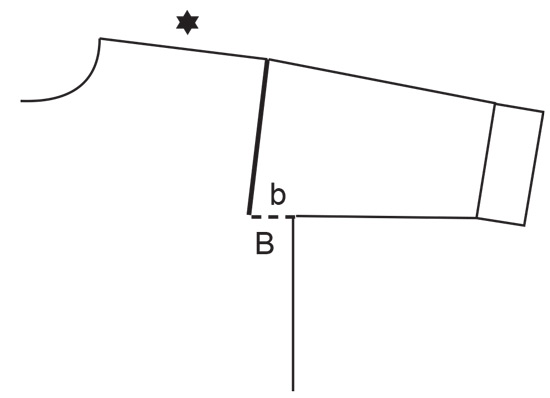
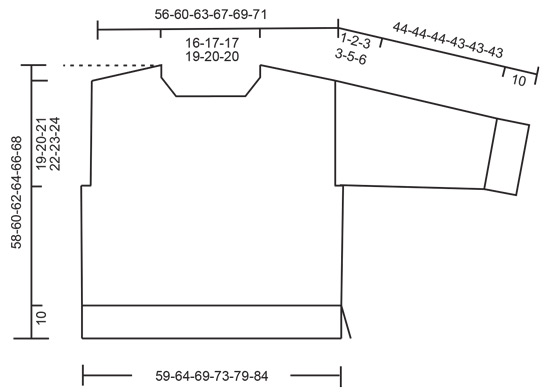
What can you do with our patterns? You can share DROPS patterns online, using the pattern original picture, materials, name and number. But you are NOT ALLOWED to reproduce the complete pattern digitally in any way. Yarn stores are welcome to use the DROPS pattern database to promote the sale of our assortment. You can print out our patterns, make as many copies as you’d like. The only thing we ask is that you don't make any changes / additions to the original printed document. And that the patterns according to the DROPS philosophy are given out to the consumers for free. Editorials that wish to publish our patterns in printed books or magazines can contact us for more information. The sale of garments based on DROPS patterns is permitted as long as they are sold as single items or per order. Further commercial use of the patterns is not permitted. It has to be clearly stated that the garment is made based on a design from DROPS DESIGN. The use of clothing labels of which DROPS DESIGN forms part is conditioned by the inclusion of the following text: “A DROPS DESIGN made by …..”. The use of DROPS photos for marketing purposes/sales is only permitted in connection with the use/sale of DROPS products. The photos may not be cut or edited and the logo should be clearly visible.
We reserve the right to withdraw the permission for use of our patterns at any time, notwithstanding the reason.
Each of our patterns has specific tutorial videos to help you.
These step-by-step tutorials might also help you:
Why is the knitting/crochet tension so important?
Knitting tension is what determines the final measurements of your work, and is usually measured per 10 x 10 cm. It is provided like so: number of stitches in width x number of rows in height - eg: 19 stitches x 26 rows = 10 x 10 cm.
The knitting tension is very individual; some people knit/crochet loosely while others work tightly. You adjust the knitting tension with the needle size, which is why the suggested needle size is only meant as a guide! You need to adjust this (up or down) to ensure that YOUR knitting tension matches the knitting tension provided in the pattern. If you work with a different knitting tension than provided you will have a different yarn consumption, and your work will have different measurements than what the pattern suggests.
The knitting tension also determines which yarns can replace each other. As long as you achieve the same knitting tension you can replace one yarn with another.
See DROPS lesson: How to measure your tension/gauge
See DROPS video: How to make a gauge tension swatch
How do I know how many balls of yarn I need?
The required amount of yarn is provided in grams, eg: 450 g. To calculate how many balls you’ll need you first need to know how many grams are in 1 ball (25g, 50g or 100g). This information is available if you click on the individual yarn quality on our pages. Divide the amount required with the amount of each ball. For example, if each ball is 50g (the most common amount), the calculation will be as follows: 450 / 50 = 9 balls.
Can I use a different yarn than what the pattern suggests?
The important thing when changing from one yarn to another is that the knitting/crochet tension remains the same. This is so that the measurements of the finished piece will be the same as on the sketch provided. It is easier to achieve the same knitting tension using yarns from the same yarn group. It is also possible to work with multiple strands of a thinner yarn to achieve the knitting tension of a thicker one. Please try our yarn converter. We recommend you to always work a test swatch.
Please NOTE: when changing yarn the garment might have a different look and feel to the garment in the photo, due to individual properties and qualities of each yarn.
See DROPS lesson: Can I use a different yarn than the one mentioned in the pattern?
What are the yarn groups?
All our yarns are categorised into yarn groups (from A to F) according to thickness and knitting tension – group A contains the thinnest yarns and group F the thickest. This makes it easier for you to find alternative yarns to our patterns, should you wish to switch yarn. All yarns within the same group have a similar knitting tension and can easily replace each other. However, different yarn qualities have different structures and properties which will give the finished work a unique look and feel.
How do I use the yarn calculator?
At the top of all our patterns you’ll find a link to our yarn calculator, which is a helpful tool should you wish to use a different yarn than suggested. By filling in the yarn quality you wish to replace, the amount (in your size) and number of strands, the calculator will present good alternative yarns with the same knitting tension. Additionally it will tell you how much you’ll require in the new qualities and whether you’ll need to work with multiple strands. Most skeins are 50g (some are 25g or 100g).
If the pattern is worked with multiple colours, every colour will have to be calculated separately. Similarly, if the pattern is worked with several strands of different yarns (for example 1 strand Alpaca and 1 strand Kid-Silk) you will have to find alternatives for each, individually.
Why do you show discontinued yarns in the patterns?
Since different yarns have different qualities and textures we have chosen to keep the original yarn in our patterns. However, you can easily find options among our available qualities by using our yarn calculator, or simply pick a yarn from the same yarn group.
It is possible that some retailers still have discontinued yarns in stock, or that someone has a few skeins at home that they would like to find patterns for.
The yarn calculator will provide both alternative yarn as well as required amount in the new quality.
What size should I knit?
If you think it's hard to decide what size to make, it can be a good idea to measure a garment you own already and like the size of. Then you can pick the size by comparing those measures with the ones available in the pattern's size chart.
You'll find the size chart at the bottom of the pattern.
See DROPS lesson: How to read size chart
Why do I get the wrong knitting tension with the suggested needle size?
The needle size provided in the pattern serves only as a guide, the important thing is to follow the knitting tension. And since knitting tension is very individual, you will have to adjust the needle size to ensure that YOUR tension is the same as in the pattern – maybe you’ll have to adjust 1, or even 2 needle sizes, up or down to achieve the correct tension. For this, we recommend that you work test swatches.
Should you work with a different knitting tension than the one provided, the measurements of the finished garment might deviate from the measurement sketch.
See DROPS lesson: How to measure your tension/gauge
See DROPS video: How to make a tension/gauge swatch
Why is the pattern worked top-down?
Working a garment top-down provides more flexibility and room for personal adjustment. For example it is easier to try the garment on while working, as well as making adjustments to length of yoke and shoulder caps.
The instructions are carefully explaining every step, in the correct order. Diagrams are adjusted to the knitting direction and are worked as usual.
How do I work according to a knitting diagram?
The diagram depicts all rows/rounds, and every stitch seen from the right side. It is read from bottom to top, from right to left. 1 square = 1 stitch.
When working back and forth, every other row is worked from the right side and every other row is worked from the wrong side. When working from the wrong side, the diagram will have to be worked reversed: from left to right, knit stitches are purled, purl stitches are knit etc.
When working in the round every round is worked from the right side and the diagram are worked from right to left on all rounds.
See DROPS lesson: How to read knitting diagrams
How do I work according to a crochet diagram?
The diagram depicts all rows/rounds, and every stitch seen from the right side. It is worked from bottom to top, from right to left.
When working back and forth every other row is worked from the right side: from right to left and every other row is worked from the wrong side: from left to right.
When working in the round, every row in the diagram are worked from the right side, from right to left.
When working a circular diagram you start in the middle and work your way outwards, counter clockwise, row by row.
The rows usually start with a given number of chain stitches (equivalent to the height of the following stitch), this will either be depicted in the diagram or explained in the pattern.
See DROPS lesson: How to read crochet diagrams
How do I work several diagrams simultaneously on the same row/round?
Instructions for working several diagrams after each other on the same row/round, will often be written like so: “work A.1, A.2, A.3 a total of 0-0-2-3-4 times". This means you work A.1 once, then A.2 is worked once, and A.3 is repeated (in width) the number of times provided for your size – in this case like so: S = 0 times, M = 0 times, L=2 times, XL= 3 times and XXL = 4 times.
The diagrams are worked as usual: begin with the first row in A.1, then work the first row in A.2 etc.
See DROPS lesson: How to read knitting diagrams
See DROPS lesson: How to read crochet diagrams
Why are the sleeves shorter in larger sizes?
The total width of the garment (from wrist-to-wrist) will be larger in the larger sizes, despite the actual sleeves being shorter. The larger sizes have longer sleeve caps and wider shoulders, so there will be a good fit in all sizes.
Where on the garment is the length measured?
The measurement sketch/schematic drawing provides information regarding the full length of the garment. If it’s a jumper or a jacket the length is measured from the highest point on the shoulder closest to the neckline, and straight down to the bottom of the garment. It is NOT measured from the tip of shoulder. Similarly, the length of yoke is measured from the highest point on the shoulder and down to where yoke is split into body and sleeves.
On a jacket measures are never taken along bands, unless specifically stated. Always measure inside band stitches when measuring the length.
See DROPS lesson: How to read a schematic drawing
What is a repeat?
Diagrams are often repeated on the round or in height. 1 repeat is the diagram the way it appears in the pattern. If it says to work 5 repeats of A.1 in the round, then you work A.1 a total of 5 times after/next to each other in the round. If it says to work 2 repeats of A.1 vertically/in height you work the entire diagram once, then begin again at the start and work the entire diagram one more time.
Why does the piece start with more chain stitches than it’s worked with?
Chain stitches are slightly narrower than other stitches and to avoid working the cast-on edge too tight, we simply chain more stitches to begin with. The stitch count will be adjusted on the following row to fit the pattern and measurement sketch.
Why increase before the rib edge when the piece is worked top-down?
The rib edge is more elastic and will contract slightly compared to, for example, stocking stitch. By increasing before the rib edge, you avoid a visible difference in width between the rib edge and the rest of the body.
Why increase in the cast-off edge?
It’s very easy to cast off too tightly, and by making yarn overs while casting off (and simultaneously casting these off) you avoid a too tight cast off edge.
See DROPS video: How to bind off with yarn overs (yo)
How do I increase/decrease on every 3rd and 4th row/round alternately?
To achieve an even increase (or decrease) you can increase on, for example: every 3rd and 4th row alternately, like so: work 2 rows and increase on the 3rd row, work 3 rows and increase on the 4th. Repeat this until the increase is complete.
See DROPS lesson: Increase or decrease 1 st on every 3rd and 4th row alternately
How can I work a jacket in the round instead of back and forth?
Should you prefer to work in the round instead of back and forth, you may of course adjust the pattern. You’ll need to add steeks mid-front (usually 5 stitches), and follow the instructions. When you would normally turn and work from the wrong side, simply work across the steek and continue in the round. At the end you’ll cut the piece open, pick up stitches to work bands, and cover the cut edges.
See DROPS video: How to knit steeks and cut open
Can I work a jumper back and forth instead of in the round?
Should you prefer to work back and forth instead of in the round, you may of course adjust the pattern so you work the pieces separately and then assemble them at the end. Divide the stitches for the body in 2, add 1 edge stitch in each side (for sewing) and work the front and back pieces separately.
See DROPS lesson: Can I adapt a pattern for circular needles into straight needles?
Why is the pattern slightly different than what I see in the photo?
Pattern repeats can vary slightly in the different sizes, in order to get the correct proportions. If you’re not working the exact same size as the garment in the photo, yours might deviate slightly. This has been carefully developed and adjusted so that the complete impression of the garment is the same in all sizes.
Make sure to follow instructions and diagrams for your size!
How do I make a women’s size garment into a men’s size one?
If you have found a pattern you like which is available in women’s size it’s not very difficult to convert it to men’s size. The biggest difference will be the length of sleeves and body. Start working on the women size that you think would fit across the chest. The additional length will be worked right before you cast off for the armhole/sleeve cap. If the pattern is worked top-down you can add the length right after the armhole or before the first decrease on sleeve.
Regarding additional yarn amount, this will depend on how much length you add, but it is better with a skein too many than too few.
How do I prevent a hairy garment from shedding?
All yarns will have excess fibres (from production) that might come off as lint or shedding. Brushed yarns (ie hairier yarns) have more of these loose, excess fibres, causing more shedding.
Shedding also depends on what is worn under or over the garment, and whether this pulls at the yarn fibres. It’s therefore not possible to guarantee that there will be no shedding
Below are some tips on how to get the best result when working with hairier yarns:
1. When the garment is finished (before you wash it) shake it vigorously so the looser hairs come off. NOTE: do NOT use a lint roller, brush or any method that pulls at the yarn.
2. Place the garment in a plastic bag and put it in your freezer - the temperature will cause the fibres to become less attached to each other, and excess fibres will come off easier.
3. Leave in the freezer for a few hours before taking it out and shaking it again.
4. Wash the garment according to the instructions on the yarn label.
Why does my garment pill?
Pilling is a natural process that happens to even the most exclusive of fibers. It's a natural sign of wear and tear that is hard to avoid, and that is most visible in high friction areas of your garment like a sweater's arms and cuffs.
You can make your garment look as new by removing the pilling, using a fabric comb or a pill/lint remover.
In the meantime, you can read the questions and answers that others have left to this pattern or join the DROPS Workshop on Facebook to get help from fellow knitters/crocheters!
You might also like...
Stormy Evening Sweater |
||||
 |
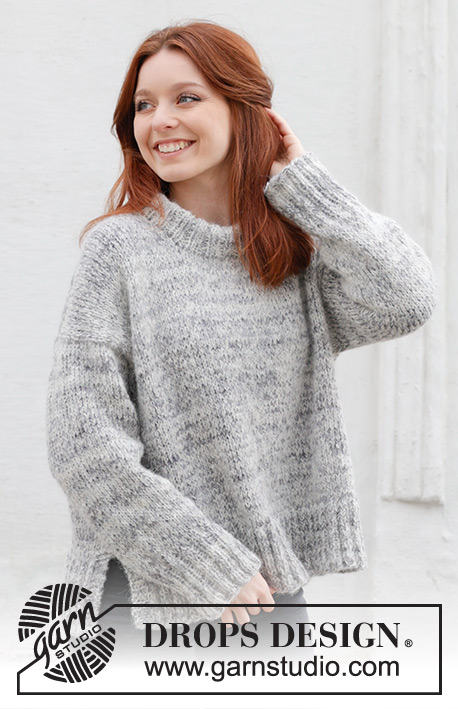 |
|||
Knitted jumper in DROPS Fabel and DROPS Brushed Alpaca Silk. The piece is worked top down in stocking stitch with European/diagonal shoulders and double neck. Sizes S - XXXL.
DROPS 245-24 |
||||
|
------------------------------------------------------- EXPLANATIONS FOR THE PATTERN: ------------------------------------------------------- INCREASE TIP FROM THE RIGHT SIDE: BEFORE MARKER: The new stitch twists to the right. Use left needle to pick up thread between 2 stitches from row below, pick up thread from behind and knit stitch in front loop. AFTER MARKER: The new stitch twists to the left. Use left needle to pick up thread between 2 stitches from row below, pick up thread from front and knit stitch in back loop. INCREASE TIP FROM THE WRONG SIDE: BEFORE MARKER: The new stitch twists to the right. Use left needle to pick up thread between 2 stitches from row below, pick up thread from front and purl stitch in back loop. AFTER MARKER: The new stitch twists to the left. Use left needle to pick up thread between 2 stitches from row below, pick up thread from behind and purl stitch in front loop. GARTER STITCH (worked in the round): 1 ridge in height = 2 rounds; Knit 1 round and purl 1 round. GARTER STITCH (worked back and forth): Knit all rows. 1 ridge = knit 2 rows. DECREASE TIP (for sleeves): Decrease 1 stitch on each side of the marker-thread as follows: Work until there are 3 stitches left before the marker-thread, knit 2 together, knit 2 (marker-thread sits between these 2 stitches), slip 1 stitch knit-wise, knit 1 and pass the slipped stitch over the knitted stitch. ------------------------------------------------------- START THE PIECE HERE: ------------------------------------------------------- JUMPER – SHORT OVERVIEW OF THE PIECE: The back piece is worked top down, back and forth with circular needle, until the armholes are finished. Stitches are knitted up along each shoulder on the back piece, increased for the neck and the front piece is worked back and forth with circular needle until the armholes are finished. The two pieces are joined and the body worked in the round with circular needle as far as the split, then finished back and forth. Stitches are knitted up around each armhole, the sleeve cap is worked back and forth, then the sleeves are finished in the round with circular needle/double pointed needles. The neck is worked in the round to finish. BACK PIECE: Cast on 26-28-28-30-32-32 stitches with circular needle size 6 mm, 1 strand DROPS Fabel and 1 strand DROPS Brushed Alpaca Silk (2 strands). Purl 1 row from the wrong side. Insert 1 marker inside the 3 outermost stitches on each side. Continue with stocking stitch back and forth. AT THE SAME TIME, on the first row from the right side, increase AFTER the marker at the beginning of the row and BEFORE the marker at the end of the row - read INCREASE TIP FROM RIGHT SIDE. On the next row (wrong side) increase in the same way - read INCREASE TIP FROM WRONG SIDE. Continue increasing on each row, from both the right and wrong side, a total of 26-28-30-32-32-34 times = 78-84-88-94-96-100 stitches. The piece is now measured from here! REMEMBER THE KNITTING TENSION! Continue with stocking stitch back and forth for 15-15-16-17-18-19 cm, measured along the armhole. Cut the strand. FRONT PIECE: Start on the left shoulder (when the garment is worn). Knit up 26-28-30-32-32-34 stitches inside 1 edge stitch along the left shoulder on back piece (i.e., 1 stitch in each row). Work stocking stitch back and forth. When the piece measures 5 cm from the knitted-up stitches, increase 1 stitch (as above) at the beginning of each row from the right side for the neck, increasing only after the first 3 stitches from the right side. Increase 1 stitch 4 times = 30-32-34-36-36-38 stitches. Purl 1 row from the wrong side, cut the strand and work the right shoulder as follows. Knit up 26-28-30-32-32-34 stitches inside 1 edge stitch along the right back shoulder. Work stocking stitch back and forth. When the piece measures 5 cm from the knitted-up stitches, increase 1 stitch at the end of each row from the right side for the neck, increasing only before the last 3 stitches from the right side. Increase 1 stitch 4 times = 30-32-34-36-36-38 stitches. Purl back from the wrong side Work the next row as follows from the right side: Work the 30-32-34-36-36-38 stitches from the right front piece, cast on 18-20-20-22-24-24 stitches for the neck, work the 30-32-34-36-36-38 stitches from the left front piece = 78-84-88-94-96-100 stitches. Work stocking stitch back and forth until the piece measures 23-25-26-27-28-29 cm, measured along the armhole. Now join the front and back pieces for the body. BODY: Work the 78-84-88-94-96-100 stitches from the front piece, cast on 4-6-8-8-14-18 stitches under the sleeve, work the 78-84-88-94-96-100 stitches from the back piece, cast on 4-6-8-8-14-18 stitches = 164-180-192-204-220-236 stitches. Insert a marker-thread in the middle of the cast-on stitches under each sleeve – they are used when dividing for the split. Work stocking stitch in the round until the piece measures 46-48-50-52-54-56 cm from the top of the shoulder on the front piece. Now start the round 4 stitches before 1 marker-thread. Work 8 GARTER STITCHES – read description above, under each sleeve (i.e., 4 stitches on each side of both marker-threads), the other stitches continued in stocking stitch, until the piece measures 48-50-52-54-56-58 cm (with the last row being a knitted row in the garter stitches). Divide at the marker-threads, place the 82-90-96-102-110-118 stitches from the back piece on a stitch holder and work the front piece. FRONT PIECE: = 82-90-96-102-110-118 stitches. Work as follows from the right side: 4 garter stitches, knit 74-82-88-94-102-110 stitches and increase 44-44-50-52-56-60 stitches evenly spaced over these stitches (yarn overs which are worked twisted on the next row), 4 garter stitches = 126-134-146-154-166-178 stitches. Change to circular needle size 5 mm. Work rib as follows from the wrong side: 4 garter stitches, * purl 2, knit 2 *, work from *-* until there are 6 stitches left, purl 2, 4 garter stitches. Work this rib back and forth for 10 cm. Cast off with rib. The jumper measures approx. 58-60-62-64-66-68 cm, measured from the top of the shoulder on the front piece. BACK PIECE: Place the 82-90-96-102-110-118 stitches from the stitch holder on circular needle size 6 mm and work in the same way as the front piece. LEFT SLEEVE: Use circular needle size 6 mm, 1 strand DROPS Fabel and 1 strand DROPS Brushed Alpaca Silk (2 strands). Knit up from the right side 33-35-36-38-40-41 stitches from the bottom of the armhole (along front piece), up the front piece to the shoulder, then 21-21-22-24-24-27 stitches down the back piece to the bottom of the armhole = 54-56-58-62-64-68 stitches. Insert 1 marker in the middle of the row – the sleeve is measured from this marker. Work stocking stitch back and forth for 1-2-3-3-5-6 cm. Now join the sleeve and continue in the round with short circular needle/double pointed needles size 6 mm. Insert 1 marker-thread at the beginning of the round (mid-under sleeve) and allow it to follow your work onwards. Start at the marker-thread and work stocking stitch in the round. When the sleeve measures 4-4-4-4-5-7 cm, decrease 1 stitch on each side of the marker-thread - read DECREASE TIP. Decrease like this every 5-5-5-4-4-3 cm a total of 6-6-6-7-7-8 times = 42-44-46-48-50-52 stitches. Continue working until the sleeve measures 34-34-34-33-33-33 cm from the marker. There is 10 cm left; try the jumper on and work to desired length before the rib. Knit 1 round and increase 6-4-6-4-6-8 stitches evenly spaced = 48-48-52-52-56-60 stitches. Change to double pointed needles size 5 mm. Work rib (knit 2, purl 2) for 10 cm. Cast off a little loosely. The sleeve measures approx. 44-44-44-43-43-43 cm from the marker. Work the other sleeve in the same way but knit up 21-21-22-24-24-27 stitches up the back piece to the shoulder and 33-35-36-38-40-41 stitches down the front piece. Sew the bottom of the armholes together – see sketch. NECK: Start on one shoulder-line and knit up from the right side, inside 1 edge stitch, 76 to 96 stitches with short circular needle size 5 mm and 1 strand of each quality. The stitch count should be divisible by 4. Work rib in the round (knit 2, purl 2) for 9 cm. Cast off with rib. Fold the neck double to the inside and sew down. To avoid the neck being tight and rolling outwards, it is important that the seam is elastic. |
||||
Diagram explanations |
||||
|
||||

|
||||

|
||||
|
Have you made this or any other of our designs? Tag your pictures in social media with #dropsdesign so we can see them! Do you need help with this pattern?You'll find tutorial videos, a Comments/Questions area and more by visiting the pattern on garnstudio.com. © 1982-2024 DROPS Design A/S. We reserve all rights. This document, including all its sub-sections, has copyrights. Read more about what you can do with our patterns at the bottom of each pattern on our site. |
||||
With over 40 years in knitting and crochet design, DROPS Design offers one of the most extensive collections of free patterns on the internet - translated to 17 languages. As of today we count 304 catalogues and 11422 patterns - 11422 of which are translated into English (UK/cm).
We work hard to bring you the best knitting and crochet have to offer, inspiration and advice as well as great quality yarns at incredible prices! Would you like to use our patterns for other than personal use? You can read what you are allowed to do in the Copyright text at the bottom of all our patterns. Happy crafting!







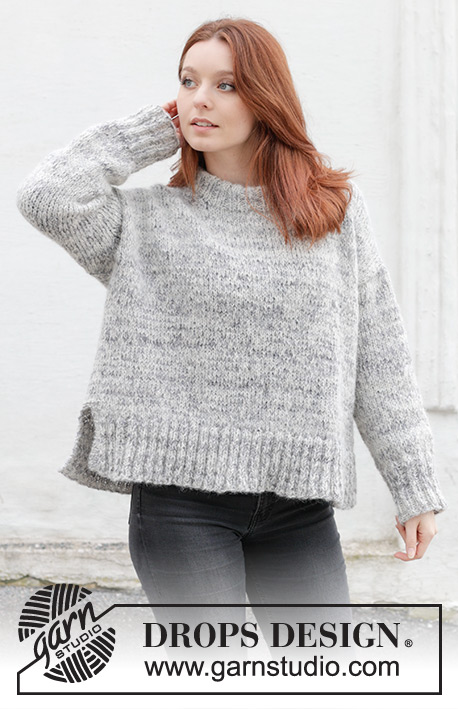
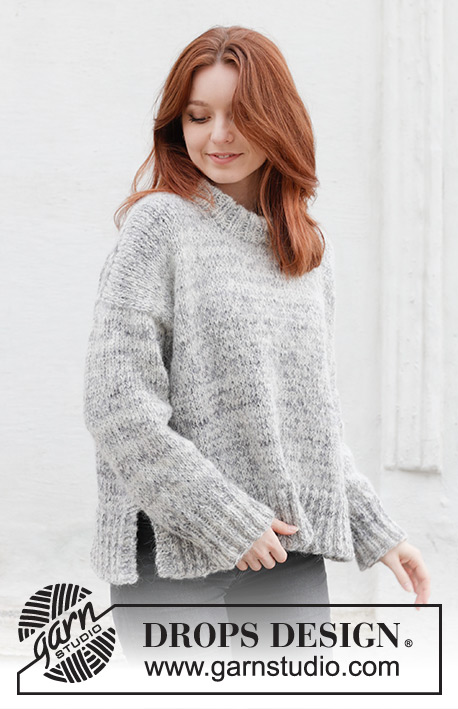
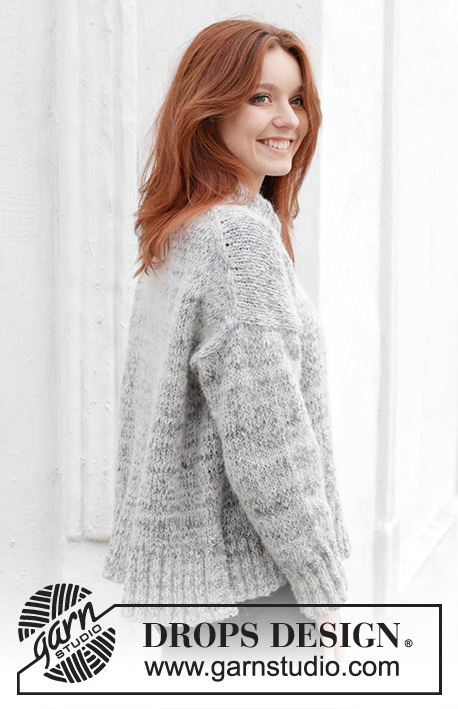

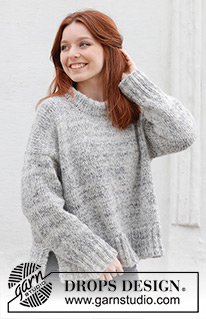
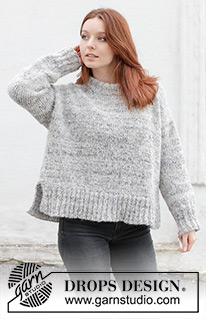
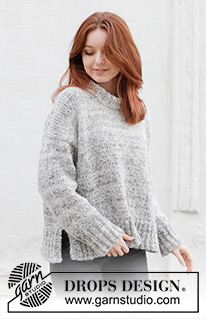




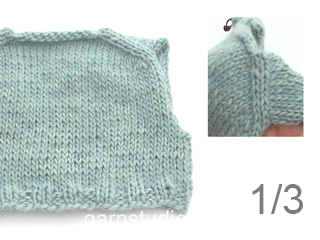
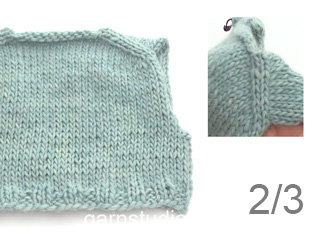
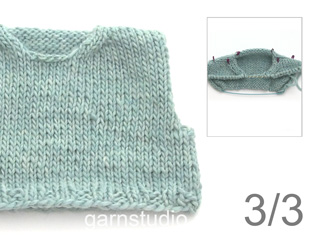

























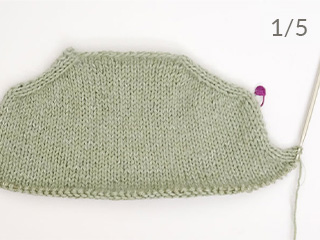
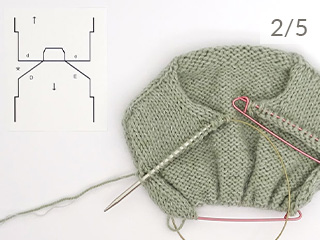
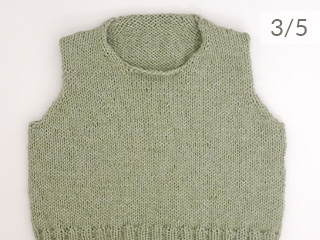

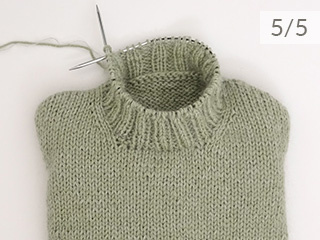





















Comments / Questions (2)
I mönstret står det att man börjar plocka upp maskor i vänster axel, men videon visar högra axeln, blir det någon skillnad?
30.12.2023 - 09:39DROPS Design answered:
Hei Hson. Om du ser videoen slik at du får en oversikt over teknikken, og deretter strikker du slik det er forklart i oppskriften (DROPS 245-24). Videoen er en generell video og oppskrifter kan variere litt fra oppskrift til oppskrift. mvh DROPS Design
08.01.2024 - 13:58PRZÓD: Przerabiać w tę i z powrotem dżersejem, aż długość robótki wynosi 23-25-26-27-28-29 cm, mierzyć wzdłuż podkroju rękawa. - gdzie jest podkroj rękawa? Odkąd dokładnie to liczymy? Dopiero zaczynam prace ze wzorami, dziękuje za odpowiedz :)
29.10.2023 - 17:36DROPS Design answered:
Witaj Wiolu, mierzysz od nabranych oczek na lewe/prawe ramię przodu i dalej w dół, wzdłuż brzegu przodu. Pozdrawiamy!
30.10.2023 - 08:17